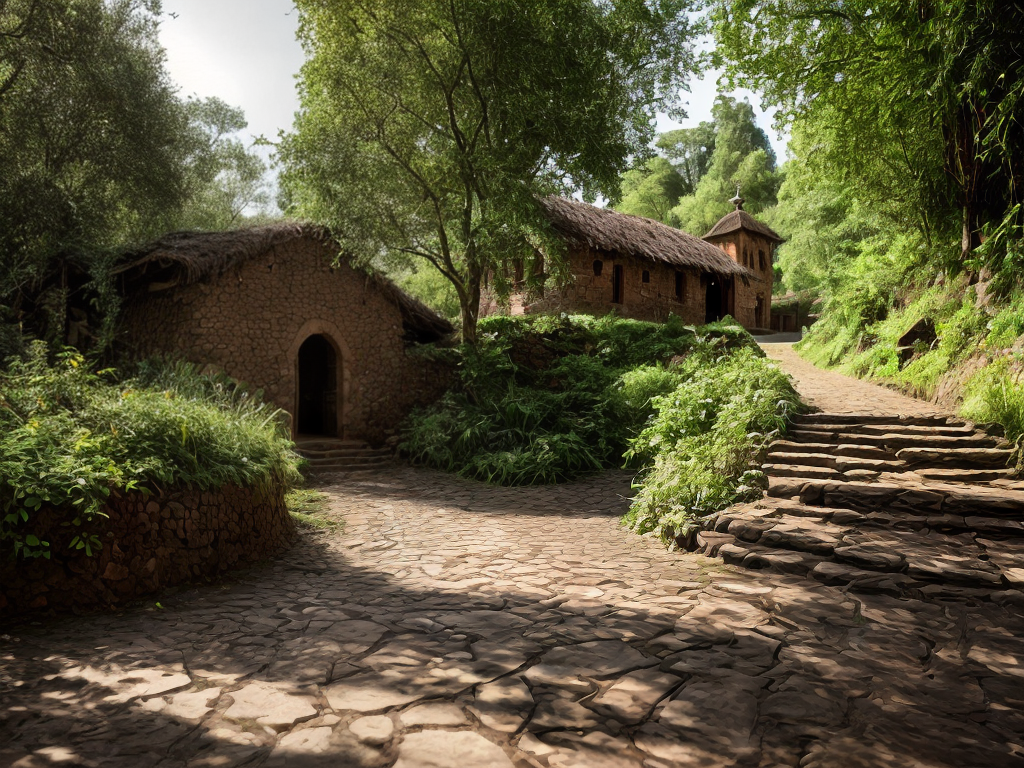Lalibela, a land of ancient wonder and spiritual significance, beckons the curious traveler to embark on a journey through its rock-hewn churches. These majestic monuments, meticulously carved from solid rock, stand as a testament to the ingenuity and devotion of their creators. But beyond their awe-inspiring architecture lies a rich tapestry of history, legend, and tradition waiting to be unraveled. As I step into this enchanting world, I invite you to join me on a captivating exploration of Lalibela’s sacred sanctuaries, where each step promises to reveal hidden treasures and illuminate the depths of Ethiopian Christianity.
History of Lalibela’s Churches
The history of Lalibela’s churches is a remarkable tale of faith, engineering prowess, and cultural significance. These rock-hewn churches, located in the town of Lalibela in northern Ethiopia, have mythical origins that trace back to the 12th century. According to legend, King Lalibela was divinely inspired to construct these churches as a “New Jerusalem” after he visited the real Jerusalem and was unable to build a church there due to political turmoil.
The historical significance of Lalibela’s churches cannot be overstated. They are not only important religious sites for Ethiopian Orthodox Christians but also UNESCO World Heritage sites that attract tourists from around the world. The churches were meticulously carved out of solid rock, with each building intricately designed and decorated with religious symbols and biblical scenes. The engineering feat of creating these structures without modern tools is awe-inspiring and a testament to the ingenuity of the people of that time.
Beyond their religious and architectural significance, the churches of Lalibela also hold cultural importance for the Ethiopian people. They are a symbol of their rich history and heritage, showcasing the country’s ancient Christian traditions. The annual pilgrimage to Lalibela attracts thousands of believers who come to pay homage to these sacred sites.
Legend and Mythology Surrounding the Churches
Legend and mythology envelop the rock-hewn churches of Lalibela, adding an aura of mystique to their already extraordinary history. These legendary stories are deeply intertwined with the historical significance of the churches, further enhancing their allure.
One of the most captivating legends surrounding Lalibela is the belief that the churches were not built by human hands, but rather by angels or divine beings. According to the folklore, King Lalibela, the ruler of Ethiopia in the 12th century, received divine inspiration to construct these churches as a new Jerusalem. It is said that angels worked alongside the king, completing the churches at night while he slept.
Another fascinating legend tells the story of King Lalibela’s journey to Jerusalem. It is believed that he traveled there in a dream, where he received instructions from God to build the churches in Lalibela. Upon his return, the king set out to fulfill this divine command, and the rock-hewn churches came into existence.
These legends not only add an element of mystery to the churches but also highlight their spiritual significance. The rock-hewn churches of Lalibela are not only architectural marvels but also sacred sites deeply rooted in Ethiopian Orthodox Christianity.
Exploring the legend and mythology surrounding the rock-hewn churches of Lalibela offers a unique perspective on their historical significance. These stories provide insight into the spiritual beliefs and cultural heritage of the Ethiopian people. They contribute to the sense of wonder and awe that visitors experience when they witness these remarkable structures firsthand.
Architecture and Design of the Rock-Hewn Churches
The rock-hewn churches of Lalibela boast unique rock formations and intricate carvings that showcase the architectural and design ingenuity of their creators. These churches were carved directly into the solid rock, with each one having its own distinct features and characteristics. The intricate carvings found both inside and outside the churches reflect the skill and craftsmanship of the ancient architects, making the rock-hewn churches of Lalibela a true marvel of human creativity and engineering.
Unique Rock Formations
With their intricately carved facades and impressive structural design, Lalibela’s rock-hewn churches stand as a testament to the architectural ingenuity of the ancient Ethiopian civilization. But beyond the man-made wonders lies the natural formations that make Lalibela truly unique. Here are some of the geological wonders that surround the rock-hewn churches:
- The Landscape of Tigray: The region surrounding Lalibela is known for its breathtaking cliffs, deep canyons, and rugged mountains, creating a picturesque backdrop for the churches.
- The Underground Tunnels: Beneath Lalibela’s surface, a network of tunnels and passageways connects the churches, adding an air of mystery and intrigue to the site.
- The Sacred Cave: Located near the churches, this natural cave is believed to have served as a spiritual retreat for the ancient Ethiopian priests.
- The Rock Pillars: Rising from the ground, these towering rock pillars provide a stunning natural contrast to the intricate carved structures above.
These natural formations, combined with the man-made rock-hewn churches, create a truly awe-inspiring experience for visitors exploring Lalibela.
Intricate Carvings
Admiring the exquisite craftsmanship and attention to detail, one can’t help but marvel at the intricate carvings that adorn Lalibela’s rock-hewn churches. These architectural wonders showcase the mastery of intricate carving techniques employed by the craftsmen of the time. Every surface of the churches is covered with intricate designs, depicting scenes from biblical stories and Ethiopian history. The carvings showcase an incredible level of skill and precision, with each detail meticulously carved into the rock. Symbolism in rock art is also evident throughout the carvings, with motifs representing religious and cultural significance. The carvings not only serve as decorative elements but also convey a deeper meaning, allowing visitors to connect with the rich history and spirituality of Lalibela. It is truly awe-inspiring to witness the artistry and symbolism captured in these remarkable carvings.
Significance of Lalibela’s Churches in Ethiopian Christianity
Lalibela’s churches hold immense significance within Ethiopian Christianity, serving as a testament to the country’s rich religious heritage. These rock-hewn churches are not only architectural marvels but also deeply rooted in the spiritual and cultural fabric of Ethiopia. Here are some key aspects that highlight the significance of Lalibela’s churches in Ethiopian Christianity:
-
Influences on Lalibela’s church architecture: The rock-hewn churches of Lalibela were built in the 12th century under the reign of King Lalibela. Inspired by Jerusalem, Lalibela sought to create a new Jerusalem in Ethiopia. This influence can be seen in the architectural features, such as the cruciform layout, intricate carvings, and symbolic motifs found throughout the churches.
-
Ethiopian Orthodox Christianity in Lalibela: Lalibela is considered one of the holiest sites in Ethiopian Orthodox Christianity. The churches are pilgrimage destinations for thousands of Ethiopian Orthodox Christians who come to seek spiritual solace and connect with their faith. The religious rituals and ceremonies held in these churches are deeply significant to the local community and contribute to the preservation of the Ethiopian Orthodox Christian tradition.
-
Symbolism and spirituality: Each church in Lalibela has its own unique symbolism and religious significance. The churches represent different aspects of the Christian faith, such as the nativity, crucifixion, and resurrection of Jesus Christ. The intricate carvings and frescoes within the churches depict biblical scenes and saints, creating a spiritual atmosphere that resonates with worshippers.
-
Cultural heritage: Lalibela’s churches are not only religious sites but also a symbol of Ethiopia’s cultural heritage. They showcase the architectural and artistic skills of the medieval Ethiopian civilization, making them an important part of the nation’s history. The churches are recognized as a UNESCO World Heritage Site, further emphasizing their significance on a global scale.
Exploring the Northern Group of Churches
When exploring the Northern Group of Churches in Lalibela, one can marvel at the architectural wonders and delve deeper into the religious and historical significance of these sacred sites. This group consists of four rock-hewn churches: Biete Medhane Alem, Biete Maryam, Biete Meskel, and Biete Denagel.
Hidden within the rock, these churches hold a wealth of hidden treasures and archaeological discoveries that have fascinated historians and archaeologists for centuries. Each church has its own unique features and stories to tell.
Biete Medhane Alem, the largest of the churches, is believed to house the Ark of the Covenant. Its impressive size and intricate carvings showcase the skill and dedication of the craftsmen who built it.
Biete Maryam, dedicated to the Virgin Mary, is known for its beautiful frescoes and its unique cross-shaped design. It is said that King Lalibela himself supervised its construction.
Biete Meskel, dedicated to the finding of the True Cross, is famous for its stunning paintings and its underground crypt. This crypt is believed to have been used as a burial place for the royal family.
Lastly, Biete Denagel, also known as the House of Virgins, is believed to have been used as a convent for nuns. It is a small and intimate church with intricate carvings and hidden chambers.
Exploring the Northern Group of Churches in Lalibela is an awe-inspiring experience. The hidden treasures and archaeological discoveries that await within these sacred sites offer a glimpse into Ethiopia’s rich religious and historical past.
Secrets of the Southern Group of Churches
As I approached the Southern Group of Churches in Lalibela, I couldn’t help but be awed by the hidden architectural wonders that lay before me. The intricate carving techniques used to create these rock-hewn structures were truly remarkable. As I explored further, I discovered that every rock art in these churches held deep symbolism, telling stories of faith and spirituality.
Hidden Architectural Wonders
Nestled within the rugged terrain of Lalibela, the Southern Group of Churches reveals its hidden architectural wonders, captivating visitors with its awe-inspiring craftsmanship. These ancient rock-hewn churches showcase remarkable hidden architectural techniques that continue to baffle experts to this day. Here are four intriguing features that make these churches truly extraordinary:
- Underground Passageways: The Southern Group of Churches boasts a network of secret tunnels and passageways, connecting the different churches and allowing for discreet movement.
- Hidden Chambers: Within the churches, there are concealed chambers that served various purposes, from storage to secret meeting places.
- Intricate Carvings: The walls of the churches are adorned with elaborate carvings, depicting biblical scenes and religious figures, showcasing the skill and artistry of the craftsmen.
- Subterranean Water Systems: Ingeniously designed water channels and cisterns were created beneath the churches, ensuring a reliable water supply for the community.
Exploring these hidden architectural wonders is a truly immersive experience, allowing visitors to step back in time and marvel at the ingenuity of the ancient builders.
Intricate Carving Techniques
The intricate carving techniques employed in the Southern Group of Churches reveal the exceptional skill and artistic talent of the ancient craftsmen. These techniques, which were used to create the stunning rock-hewn churches, are a testament to the rich history and cultural significance of Lalibela. The carvings found in these churches are incredibly detailed and intricate, showcasing the mastery of the craftsmen who created them. The historical significance of these carvings cannot be understated, as they provide a window into the religious and cultural practices of the time. Each carving tells a story and serves as a visual representation of the beliefs and traditions of the people who built these churches. Exploring the carvings in the Southern Group of Churches is a truly captivating experience, allowing visitors to marvel at the craftsmanship and immerse themselves in the history of Lalibela.
Symbolism in Rock Art
Moving from the intricate carving techniques employed in the Southern Group of Churches, we now delve into the fascinating topic of symbolism in the rock art found within these ancient structures. The symbolism in the rock art of Lalibela’s churches offers a glimpse into the beliefs and cultural practices of the time. Here are some key aspects to consider when interpreting these ancient symbols:
- Geometric patterns: The use of geometric patterns in the rock art represents the concept of divinity and the eternal nature of God.
- Biblical scenes: Rock art depicting biblical scenes, such as the Nativity or the Crucifixion, serves as a visual representation of important religious events.
- Animal symbolism: Animals are often depicted in the rock art, with each species holding specific meanings. For example, lions symbolize strength and power, while birds represent spirituality and the divine.
- Crosses and symbols: Various crosses and symbols, such as the Ethiopian cross or the Chi-Rho symbol, are found in the rock art and signify Christian faith and devotion.
Interpreting these ancient symbols allows us to gain a deeper understanding of the religious and cultural significance of Lalibela’s rock-hewn churches.
Hidden Passageways and Tunnels of Lalibela
Hidden beneath the ancient rock-hewn churches of Lalibela are a network of intricate passageways and tunnels, revealing a fascinating underground world waiting to be explored. These hidden passageways hold great historical significance, providing insights into the construction and purpose of the churches.
The passageways of Lalibela were not simply built as an architectural feat, but rather served practical and religious purposes. They allowed for easy access between the different churches and provided shelter and protection for the pilgrims who traveled to Lalibela. These underground tunnels also played a role in the spiritual rituals and processions that took place within the churches.
To further understand the significance of these hidden passageways, let’s take a closer look at some of the key features and functions:
| Feature | Function |
|---|---|
| Ventilation shafts | Provided fresh air circulation within the underground tunnels |
| Water drainage systems | Prevented flooding and ensured the passageways remained dry |
| Secret chambers | Used for storing religious artifacts and treasures |
| Escape routes | Provided a means of escape during times of danger or invasion |
| Symbolic pathways | Represented a journey through the spiritual realm |
Exploring the hidden passageways and tunnels of Lalibela is like stepping back in time, allowing us to connect with the ancient traditions and beliefs of the Ethiopian people. As we navigate through these underground corridors, we can’t help but feel a sense of awe and wonder at the ingenuity and craftsmanship of those who created them.
Visiting the Iconic Church of St. George
When visiting Lalibela, one cannot miss the iconic Church of St. George. This magnificent rock-hewn church, also known as Bete Giyorgis, is a true masterpiece of architecture and holds great religious significance. Here are some key things to know about the St. George Church:
-
Architectural Wonder: The St. George Church is renowned for its unique design and architectural ingenuity. Carved entirely out of a single piece of rock, the church is shaped like a cross, with intricate details and decorative motifs adorning its walls. The precision and craftsmanship of the rock-hewn structure is truly awe-inspiring.
-
Religious Significance: St. George Church holds immense religious importance for the Ethiopian Orthodox Christians. Dedicated to St. George, the patron saint of Ethiopia, the church is a place of pilgrimage and worship. It is believed that a visit to this sacred site grants spiritual blessings and protection.
-
Symbolism: The cross-shaped design of St. George Church holds deep symbolism. The four arms of the cross represent the four Gospels, and the central shaft symbolizes the unity of the church. The entire structure is a physical manifestation of faith and devotion.
-
Spiritual Experience: Stepping into the St. George Church is a truly profound and intimate experience. The dimly lit interior, adorned with religious paintings and ancient artifacts, creates an atmosphere of reverence and tranquility. The echo of prayers and the scent of incense fill the air, transporting visitors into a world of spirituality.
Visiting the St. George Church is an unforgettable journey into the heart of Ethiopian religious and architectural heritage. Its grandeur and sacredness make it a must-see destination for anyone exploring the wonders of Lalibela.
Marveling at the Intricate Carvings and Frescoes
As I stepped inside the rock-hewn churches of Lalibela, I was immediately captivated by the ancient artistry unveiled before my eyes. The masterful rock carvings, intricately crafted over centuries, showcased the immense skill and dedication of the craftsmen who created them. Every corner of the churches was adorned with vibrant frescoes, depicting biblical scenes and saints in vivid colors, adding a sense of divine beauty to the already awe-inspiring surroundings.
Ancient Artistry Unveiled
Marveling at the intricate carvings and frescoes in Lalibela’s rock-hewn churches is an awe-inspiring experience. The ancient artistry on display reveals the remarkable craftsmanship and devotion of the artisans who created these masterpieces. Here are some fascinating aspects to explore:
-
Hidden underground passageways: These secret tunnels, connecting the churches, were used by priests and pilgrims for private prayers and processions. Walking through these passages gives a sense of the spiritual journey taken by the faithful.
-
Spiritual significance of the artwork: Each carving and fresco holds deep religious symbolism, depicting scenes from the Bible and Ethiopian Orthodox traditions. The artwork serves as a visual representation of faith and helps to immerse visitors in the spiritual atmosphere of the churches.
-
Intricate carvings: The rock-hewn churches are adorned with intricately carved details, showcasing the skill of the craftsmen. From delicate floral motifs to geometric patterns, the carvings are a testament to the talent and dedication of the artists.
-
Vibrant frescoes: The vibrant frescoes, painted directly onto the rock walls, depict biblical figures and stories. The use of bold colors and intricate brushwork creates a visually stunning experience, transporting visitors to a different era.
Exploring Lalibela’s rock-hewn churches allows you to appreciate the ancient artistry and connect with the rich spiritual heritage of this remarkable UNESCO World Heritage site.
Masterful Rock Carvings
After admiring the spiritual significance and vibrant artwork in Lalibela’s rock-hewn churches, the next captivating aspect to explore is the masterful rock carvings that adorn these architectural wonders. The rock carving techniques employed in Lalibela display an astonishing level of skill and precision. The intricate details and delicate craftsmanship of the carvings are a testament to the artistic prowess of the craftsmen who created them. These carvings depict biblical scenes, saints, and various religious symbols, offering a glimpse into the rich history and cultural heritage of the region. Beyond their aesthetic appeal, these carvings hold historical significance, providing valuable insights into the religious practices and beliefs of the time. Marveling at these masterful rock carvings is sure to leave visitors in awe of the remarkable skill and artistry of Lalibela’s craftsmen.
Vibrant Church Frescoes
The vibrant church frescoes in Lalibela captivate visitors with their intricate carvings and captivating artwork. These frescoes, dating back to the 12th century, are an integral part of Lalibela’s cultural heritage. Here are some key aspects to know about the frescoes:
- Cultural Significance: The frescoes hold immense cultural significance as they depict biblical stories and religious figures, serving as a visual representation of the Christian faith.
- Intricate Detailing: The frescoes showcase remarkable attention to detail, with vibrant colors and elaborate patterns that bring the scenes to life.
- Fresco Restoration Methods: Over the years, efforts have been made to preserve and restore these ancient frescoes. Conservationists use delicate techniques like cleaning, consolidation, and retouching to prevent further deterioration while maintaining the integrity of the original artwork.
- Spiritual Experience: Standing in the presence of these frescoes can be a deeply spiritual experience, connecting visitors to the rich history and religious traditions of Lalibela.
Religious Ceremonies and Festivals at Lalibela
Religious ceremonies and festivals at Lalibela offer a captivating glimpse into the rich cultural and spiritual heritage of this ancient Ethiopian town. The town is renowned for its rock-hewn churches, but it is during these religious ceremonies that the true essence of Lalibela comes alive.
Traditional rituals are an integral part of the religious ceremonies in Lalibela. One of the most significant ceremonies is Timkat, which celebrates the baptism of Jesus in the Jordan River. During this festival, the churches are adorned with colorful decorations, and processions are held throughout the town. Pilgrims and locals gather to witness the sacred ceremonies, which include chanting, singing, and prayers. It is a time of joy and devotion, as the community comes together to honor their faith.
Another important festival in Lalibela is Meskel, which commemorates the finding of the True Cross by Empress Helena, the mother of Constantine the Great. Meskel is celebrated with great fervor and involves the lighting of a large bonfire called the Demera. The bonfire represents the discovery of the True Cross and is a symbol of hope and light. The festival also includes religious processions, traditional dances, and feasting.
Attending these religious ceremonies and festivals in Lalibela provides a unique opportunity to witness the spiritual devotion and cultural traditions of the Ethiopian people. It is a chance to immerse oneself in the vibrant atmosphere, as the town comes alive with music, dance, and religious fervor. Whether you are a religious pilgrim or simply curious about different cultures, Lalibela’s religious ceremonies and festivals offer an intimate and unforgettable experience.
Preservation Efforts and UNESCO World Heritage Site Status
Preserving the cultural heritage of Lalibela’s rock-hewn churches and securing its UNESCO World Heritage Site status has been a priority for the local community and international organizations. The unique architecture and religious significance of these churches make them an invaluable part of Ethiopia’s cultural heritage. However, there are several preservation challenges that need to be addressed to ensure their long-term survival.
- Limited resources: The local community faces financial constraints in maintaining and restoring the churches. The lack of funds hampers their ability to carry out necessary conservation work.
- Environmental factors: Lalibela is located in a region prone to natural disasters such as earthquakes and flooding. These environmental factors pose a constant threat to the structural integrity of the rock-hewn churches.
- Tourism impact: While tourism brings economic benefits to the local community, it also presents challenges in terms of managing visitor numbers and minimizing the impact on the fragile rock-cut structures.
- Training and capacity building: It is essential to provide training and support to local communities and heritage professionals to enhance their skills in conservation and preservation techniques.
Efforts to address these challenges have been underway. The Ethiopian government, in collaboration with international organizations like UNESCO and the World Monuments Fund, has been working to raise awareness about the importance of Lalibela and secure the necessary resources for its preservation. Initiatives such as the Lalibela World Heritage Site Management Plan have been developed to guide conservation efforts and ensure the sustainable management of the site.
The impact of these preservation efforts on the local community has been significant. The recognition of Lalibela as a UNESCO World Heritage Site has not only increased international visibility and tourism but also provided opportunities for local employment and economic development. The conservation work itself has also created jobs for the local population, contributing to poverty reduction and improving the overall quality of life in the community.
Sacred Rituals and Traditions at the Churches
Throughout the centuries, generations of worshippers have engaged in sacred rituals and traditions at the rock-hewn churches of Lalibela. These ancient churches, carved out of solid rock, have been a site of religious pilgrimage and worship for the Ethiopian Orthodox Church for over 800 years. The sacred rituals and traditional practices observed at these churches are deeply rooted in the country’s rich religious heritage and cultural traditions.
| Sacred Rituals | Traditional Practices |
|---|---|
| Prayer | Fasting |
| Pilgrimage | Processions |
| Blessings | Holy Water |
Prayer is a fundamental aspect of the religious experience at Lalibela’s rock-hewn churches. Worshippers gather in the dimly lit interiors of the churches, adorned with ancient religious paintings and symbols, to offer their prayers. The churches provide a serene and sacred space for contemplation and communion with the divine.
Fasting is another important practice observed by worshippers at Lalibela. Fasting periods, such as Lent and other religious holidays, are marked with strict abstinence from certain foods and drinks. This act of self-discipline is seen as a way to purify the body and soul, and to strengthen one’s connection with God.
Pilgrimage to Lalibela is a significant spiritual journey for Ethiopian Orthodox Christians. Every year, thousands of pilgrims from across Ethiopia and beyond make their way to Lalibela to pay homage to the rock-hewn churches. The pilgrimage is a time of deep devotion and reflection, as worshippers walk long distances, often barefoot, to reach the sacred site.
Processions and blessings are also integral to the religious rituals at Lalibela. During religious holidays and special occasions, worshippers gather in processions around the churches, carrying religious artifacts and chanting hymns. These processions are accompanied by blessings from the priests, who sprinkle holy water on the pilgrims as a symbol of purification and spiritual renewal.
The sacred rituals and traditional practices at the rock-hewn churches of Lalibela are a testament to the enduring faith and devotion of the Ethiopian Orthodox Church. They provide a glimpse into the rich cultural and religious heritage of Ethiopia and offer worshippers a profound spiritual experience.
Practical Tips for Exploring Lalibela’s Churches
Before visiting Lalibela’s rock-hewn churches, it is important to be aware of the entry requirements and dress code. To enter the churches, visitors are usually required to purchase a ticket, and it is advisable to check the opening hours beforehand. Additionally, it is important to dress modestly, covering shoulders and knees, as the churches are considered sacred places.
Entry Requirements
To explore Lalibela’s rock-hewn churches, visitors must adhere to certain entry requirements. Here are some key things to keep in mind:
- Dress modestly: As these churches are religious sites, it is important to respect local customs by covering your shoulders and knees.
- Remove your shoes: Before entering each church, you will be required to remove your shoes as a sign of respect.
- Pay the entrance fee: There is a small fee to enter each church, and it is best to have cash on hand as credit card facilities may not be available.
- Follow the designated routes: To preserve the churches and ensure visitor safety, it is important to follow the designated routes and avoid touching any ancient artifacts or paintings.
Dress Code
Now let’s turn our attention to the practical tips for exploring Lalibela’s churches, starting with the dress code. When visiting these sacred sites, it is important to respect the local culture and traditions. Traditional attire holds great cultural significance in Lalibela, and wearing appropriate clothing enhances the experience. Both men and women are expected to cover their shoulders and knees. Women are advised to wear long skirts or dresses, while men should opt for long pants. It is also customary to remove your shoes before entering the churches, so wearing easily removable footwear is recommended. Adhering to the dress code not only shows respect for the local customs but also allows you to fully immerse yourself in the rich cultural heritage of Lalibela.
Local Cuisine and Cultural Experiences in Lalibela
What cultural experiences and local cuisine can be discovered in Lalibela?
When exploring Lalibela, there are a plethora of cultural experiences and local cuisine to discover. The rich Ethiopian heritage is deeply embedded in the city’s vibrant culture, and visitors can immerse themselves in the local traditions through various activities. Here are four must-try experiences:
-
Taste the Flavors of Ethiopia: Lalibela is renowned for its delicious local cuisine. From injera, a traditional sourdough flatbread, to doro wat, a spicy chicken stew, the city offers a wide range of mouthwatering dishes. Don’t forget to try tej, a honey wine, and freshly brewed Ethiopian coffee, which are staples in the local culinary scene.
-
Experience Traditional Music and Dance: Lalibela is a hub for traditional Ethiopian music and dance. The city is dotted with venues where you can witness captivating performances by local musicians and dancers. Get ready to be swept away by the rhythmic beats and energetic movements that will truly transport you into the heart of Ethiopian culture.
-
Visit Local Markets: Exploring Lalibela’s bustling markets is a must for any culture enthusiast. These vibrant markets offer a glimpse into the daily lives of the locals, and you can find a wide array of handmade crafts, textiles, spices, and traditional artifacts. Engage with the friendly vendors, learn about their products, and take home a piece of Lalibela’s cultural heritage.
-
Attend a Traditional Coffee Ceremony: Coffee holds a special place in Ethiopian culture, and attending a traditional coffee ceremony is an experience not to be missed. Engage in the ritualistic preparation of the coffee, enjoy the rich aroma, and savor every sip as you bond with the locals over this cherished beverage.
In Lalibela, cultural experiences and local cuisine go hand in hand, offering visitors an intimate and immersive journey into the heart of Ethiopian traditions.
Beyond the Churches: Exploring Lalibela’s Surroundings
Exploring Lalibela’s surroundings offers a diverse range of natural and cultural attractions that complement the city’s famous rock-hewn churches. While the churches are undoubtedly the main draw, there are numerous opportunities to immerse oneself in the beauty of nature and engage in cultural activities in Lalibela and its surrounding areas.
One of the highlights of exploring Lalibela’s surroundings is the chance to witness the stunning landscapes and unique wildlife that Ethiopia has to offer. The Simien Mountains, a UNESCO World Heritage Site, are just a few hours away from Lalibela and offer breathtaking views of jagged peaks and deep valleys. Trekking through the mountains provides an opportunity to spot rare and endangered species such as the Ethiopian wolf and the Gelada baboon.
For those interested in cultural activities, Lalibela has much to offer. The city itself is home to a vibrant market where locals gather to sell their goods, including traditional textiles, jewelry, and handicrafts. Visitors can also participate in traditional coffee ceremonies, where they can learn about the Ethiopian coffee culture and taste the rich and flavorful local brew.
Beyond Lalibela, the ancient town of Aksum, known for its archaeological sites and the famous obelisks, is a must-visit destination. The nearby Blue Nile Falls, also known as the “smoking water,” is a breathtaking natural wonder that can be reached by a short hike.
Exploring nature and engaging in cultural activities in Lalibela’s surroundings allows visitors to experience the diverse beauty of Ethiopia. From the majestic Simien Mountains to the ancient town of Aksum, there is something for everyone to enjoy in this enchanting region.







